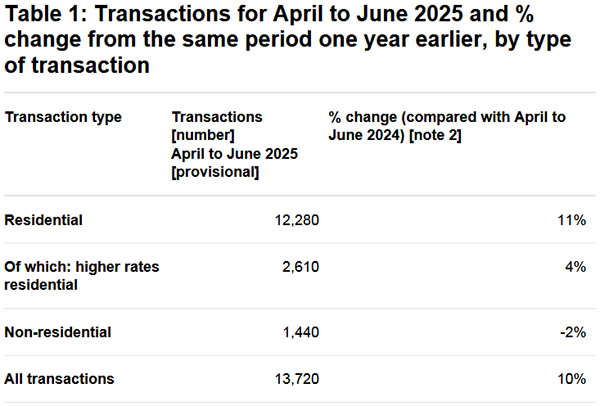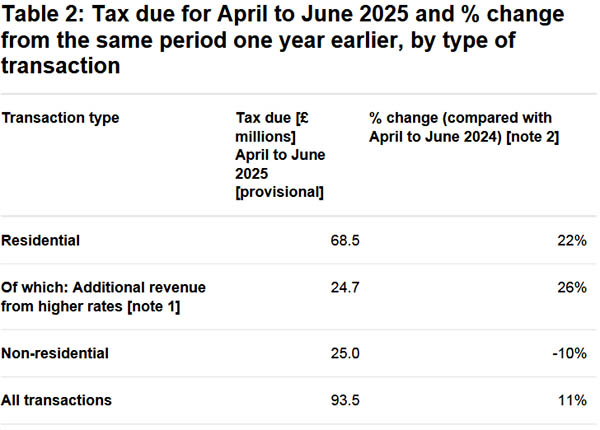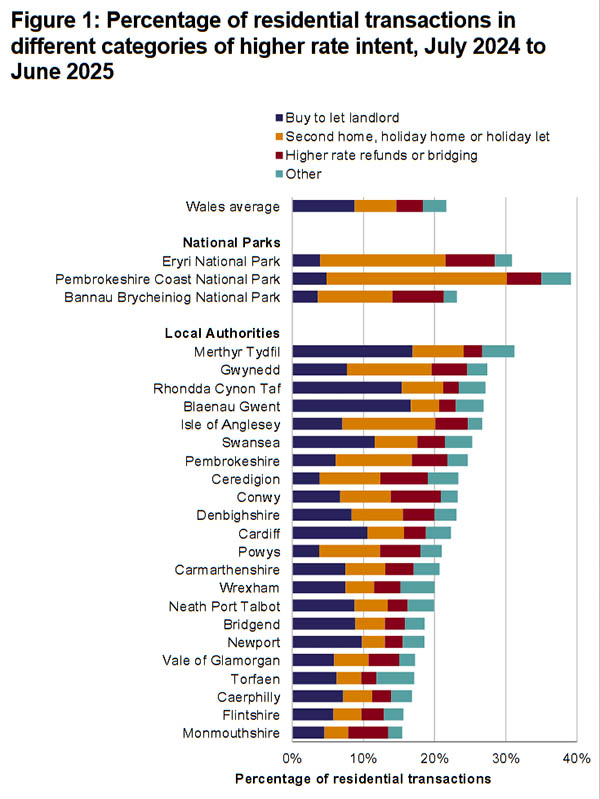 The Welsh government (Llywodraeth Cymru) has released its latest figures for Land Transaction Tax, for the period of April-June 2025.
The Welsh government (Llywodraeth Cymru) has released its latest figures for Land Transaction Tax, for the period of April-June 2025.
The quarterly Welsh Revenue Authority (WRA) statistics for Land Transaction Tax (LTT) includes data on the number of transactions, tax due and a breakdown for areas within Wales. Alongside this are number identifying the ‘intent’ of the purchase, for example a buy-to-let property or a holiday home.
The headline figures for residential transactions are:
- From April to June 2025, residential transactions were up 11% from the same quarter in 2024. The tax due was up 22%, partly influenced by the 1% increase to tax rates in all bands for higher rates residential transactions from 11th December 2024.
- In April, May and June 2025, the monthly numbers of transactions and amount of tax due were higher than the same month a year earlier.
- The percentage of transactions in the higher property bands has generally been increasing in the past seven years, though has been more stable in the past three years. The trend has been similar for the contribution of these transactions to overall tax due.
Analysing the government’s figures for the year ended June 2025 by local authority show higher-rates transactions as a percentage of all residential transactions varied from 13% in Monmouthshire to 30% in Merthyr Tydfil.
Compared with the previous year (the year ended June 2024), the local authorities with the largest percentage changes were:
- Isle of Anglesey (-8%)
- Gwynedd (-6%)
- Caerphilly, Swansea and Conwy (all -3%)
All other local authorities had changes of 2 percentage points or less.
Government figures show that in the past several years, there have generally been falls in these percentages in northern and western areas of Wales.
The percentages for Gwynedd were fairly stable from 2018-19 to 2021-22 (around 37% to 39%). There was a marked fall the next year followed by a period of stability, before another notable decrease to 26% in the year ending June 2025.
The percentages for Anglesey declined from 36% in 2019-20 to 29% in 2022-23. While there was a notable increase to 34% in the year to June 2024, there followed a larger fall to 25% in the year to June 2025.
The new data has also been analysed by ‘intent’, broken down into buy-to-let landlord; second home, holiday home or holiday let; bridging (buying a new property while trying to sell an existing one); and other.
The summary figures for this are:
- In the latest year, ‘buy-to-let landlord’ purchases made up the largest proportion of higher-rate transactions out of all residential transactions (9%), followed by ‘second home, holiday home or holiday let’ purchases (6%).
- Comparing these to the previous year, ‘buy-to-let landlord’ purchases remained at 9%, whilst ‘second home, holiday home or holiday let’ purchases decreased by one percentage point (from 7%).
- The number of ‘buy to let landlord’ purchases increased by 12% in the latest year from the previous year. This was similar to the rise for all residential transactions (15%).
- Despite that large rise in residential transactions, ‘second home, holiday home or holiday let’ purchases did not follow this increasing trend, remaining unchanged.
Local authority analysis
- ‘Buy-to-let landlord’ purchases as a percentage of residential transactions varied across local authorities, with Merthyr Tydfil and Blaenau Gwent (both 17%) having the highest percentages.
- The percentages of ‘buy-to-let landlord’ purchases in local authorities remained similar to the previous year, except for larger changes in Wrexham (down four percentage points) and Denbighshire (down two percentage points).
- In the latest year, ‘second home, holiday home or holiday let’ purchases as a percentage of residential transactions varied from 3% in each of Newport, Monmouthshire and Torfaen to 13% in the Isle of Anglesey.
- For ‘second home, holiday home or holiday let’ purchases, both Isle of Anglesey and Gwynedd saw a five-percentage point decrease in the latest year compared with the previous year, though the figures for the latest year remained higher than for any other local authority.
- Both Isle of Anglesey and Gwynedd had a higher-than-average increase in the number of main rate transactions. This may explain some of the large changes in the proportion of higher rates.
- For ‘second home, holiday home or holiday let’ purchases as a percentage of all residential transactions, the range in these figures between local authorities narrowed considerably. From a total span of 14 percentage points in the previous year, this narrowed to 10 percentage points in the latest year.
- These trends are consistent with policies around second homes in Wales having some impact on purchasing behaviour.
The full report can be found here https://www.gov.wales/land-transaction-tax-statistics-april-june-2025-html
Read the orginal article: https://propertyindustryeye.com/welsh-government-releases-latest-numbers-for-ltt-and-buyer-intent/







